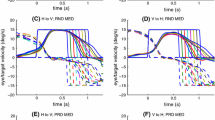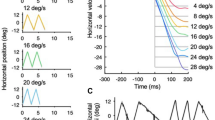Abstract
This study examined the extent to which human subjects predict future target motion for the control of smooth ocular pursuit. Subjects were required to pursue an accelerating target (0, 4 or 8°/s2) that underwent a transient occlusion, and consequently reappeared with the same or increased velocity. Presentations were received in a random or blocked order. Subjects exhibited anticipatory smooth pursuit prior to target motion onset, which in blocked presentations was scaled to the velocity generated by the target acceleration. In random presentations subjects also exhibited anticipatory smooth pursuit, but this was reflected in a more generalized response. During the transient occlusion all subjects exhibited a reduction in eye velocity, which was followed in the majority by a recovery prior to target reappearance. In random presentations, eye velocity decayed and recovered to a level that followed on from the response to the initial ramp. In blocked presentations, there was evidence of improved scaling throughout, which culminated in a significant increase in eye velocity between the start and end of the transient occlusion (8°/s2 only). These findings are difficult to reconcile with reflexive accounts of oculomotor control that perpetuate current eye motion, and hence generate a simple form of prediction using a direct efference copy (“eye-velocity memory”). Rather, they are more consistent with the scaling of smooth pursuit eye movements by means of a more-persistent velocity-based representation, which plays a significant role in both random and blocked stimulus presentations.



Similar content being viewed by others
Notes
The term “reflexive” control as used here refers to ocular pursuit movements that are initially driven by visual feedback and then perpetuated by the direct efference copy loop (Krauzlis and Lisberger 1994; Leigh and Zee 1991). We suggest that “voluntary” control represents a continuum from low-level to high-level control and is an adaptive process that enables an individual to generate a tuned response, often in the absence of sensory input (e.g., anticipatory smooth pursuit).
The term “velocity-based” is used because the direct and indirect loops receive input from retinal velocity error (i.e., retinal slip) when the participant pursues a moving target, or holds fixation in the presence of a moving target. In both cases, the velocity-based information accumulated does not equate to an allocentric representation of target velocity, but rather it represents an estimate of target image velocity.
A potential drawback of the arrangement proposed by Bennett and Barnes (2004) was that the setting of the variable gain function was influenced by both the loss of visual feedback (Conflict Detector) as well as expectation regarding the step change in target velocity. This makes it difficult to independently modulate the response, such as is necessary in sequence learning experiments, where target velocity is scaled to each ramp within the sequence but there is no loss of visual feedback (pursuing a sinusoidal trajectory presents a similar situation).
References
Barnes GR (1994) A model of predictive processes in oculomotor control based on experimental results in humans. In: Delgado-Garcia JM, Godaux E, Vidal P-P (eds) Information processing underlying gaze control. Pergamon press, New York, pp 279–290
Barnes GR, Asselman PT (1991) The mechanism of prediction in human smooth pursuit eye movements. J Physiol 439:439–461
Barnes GR, Wells SG (1999) Modelling prediction in ocular pursuit: the importance of short-term storage. In: Becker W, Deubel H, Mergner T (eds) Current oculomotor research: physiological and psychological aspects. Plenum press, New York, pp 97–107
Barnes GR, Grealy MA, Collins S (1997) Volitional control of anticipatory ocular smooth pursuit after viewing, but not pursuing, a moving target: evidence for a reafferent velocity store. Exp Brain Res 116:445–455
Becker W, Fuchs AF (1985) Prediction in the oculomotor system: smooth pursuit during transient disappearance of a visual target. Exp Brain Res 57:562–575
Bennett SJ, Barnes GR (2003) Human ocular pursuit during the transient disappearance of a visual target. J Neurophysiol 90:2504–2520
Bennett SJ, Barnes GR (2004) Predictive smooth ocular pursuit during the transient disappearance of a visual target. J Neurophysiol 92:578–590
Bennett SJ, Barnes GR (2005) Timing the anticipatory recovery in smooth ocular pursuit during the transient disappearance of a visual target. Exp Brain Res 163:198–203
Beutter BR, Stone LS (1998) Human motion perception and smooth eye movements show similar directional biases for elongated apertures. Vis Res 38:1273–1286
Boman DK, Hotson JR (1992) Predictive smooth pursuit eye movements near abrupt changes in motion direction. Vis Res 32:675–689
Carl JR, Gellman RS (1987) Human smooth pursuit: stimulus-dependent responses. J Neurophysiol 57:1446–1463
Chakraborti SR, Barnes GR, Collins CJ (2002) Factors affecting the longevity of a short-term velocity store for predictive oculomotor tracking. Exp Brain Res 144(2):152–158
Churchland MM, Chou IH, Lisberger SG (2003) Evidence for object permanence in the smooth-pursuit eye movements of monkeys. J Neurophysiol 90(4):2205–2218
Clarke AH, Ditterich J, Druen K, Schonfeld U, Steineke C (2002) Using high frame rate CMOS sensors for three-dimensional eye tracking. Behav Res Methods Instrum Comput 34(4):549–560
Jarrett CB, Barnes GR (2001) Volitional selection of direction in the generation of anticipatory smooth pursuit in humans. Neurosci Lett 312:25–28
Jarrett CB, Barnes GR (2002) Volitional scaling of anticipatory ocular pursuit velocity using precues. Cogn Brain Res 14:383–388
Kao GW, Morrow MJ (1994) The relationship of anticipatory smooth eye movement to smooth pursuit initiation. Vis Res 34:3027–3036
Kowler E (1990) The role of visual and cognitive processes in the control of eye movement. Rev Oculomot Res 4:1–7
Kowler E, Steinman RM (1979) The effect of expectations on slow oculomotor control-II. Single target displacements. Vis Res 19:633–646
Krauzlis RJ, Lisberger SG (1994) Temporal properties of visual motion signals for the initiation of smooth pursuit eye movements in monkeys. J Neurophysiol 72:150–162
Krauzlis RJ, Miles FA (1996) Transitions between pursuit eye movements and fixation in the monkey: dependence on context. J Neurophysiol 76:1622–1638
Leigh RJ, Zee DS (1991) The neurology of eye movements. F.A. Davis Company, Philadelphia
Lisberger SG, Evinger C, Johanson GW, Fuchs AF (1981) Relationship between eye acceleration and retinal image velocity during foveal smooth pursuit in man and monkey. J Neurophysiol 46:229–249
Madelain L, Krauzlis RJ (2003) Effects of learning on smooth pursuit during transient disappearance of a visual target. J Neurophysiol 90(2):972–982
Mitrani L, Dimitrov G (1978) Pursuit eye movements of a disappearing moving target. Vis Res 18:537–539
Optican LM, Zee DS, Chu FC (1985) Adaptive response to ocular muscle weakness in human pursuit and saccadic eye movements. J Neurophysiol 54:110–122
Orban de Xivry JJ, Bennett SJ, Lefèvre P, Barnes GR (2006) Evidence for synergy between saccades and smooth pursuit during transient target disappearance. J Neurophysiol 95:418–427
Pola J, Wyatt H (1997) Offset dynamics of human smooth pursuit eye movements: effects of target presence and subject attention. Vis Res 37:2579–2595
Robinson DA, Gordon JL, Gordon SE (1986) A model of the smooth pursuit eye movements system. Biol Cybern 55:43–57
Tanaka M, Lisberger SG (2000) Context-dependent smooth eye movements evoked by stationary visual stimuli in trained monkeys. J Neurophysiol 84:1748–1762
Werkhoven P, Snippe HP, Toet A (1992) Visual processing of optic acceleration. Vis Res 32:2313–2329
Acknowledgements
This work was funded by the Medical Research Council, UK
Author information
Authors and Affiliations
Corresponding author
Rights and permissions
About this article
Cite this article
Bennett, S.J., Barnes, G.R. Smooth ocular pursuit during the transient disappearance of an accelerating visual target: the role of reflexive and voluntary control. Exp Brain Res 175, 1–10 (2006). https://doi.org/10.1007/s00221-006-0533-4
Received:
Accepted:
Published:
Issue Date:
DOI: https://doi.org/10.1007/s00221-006-0533-4




